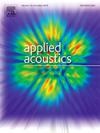Asymmetric generation of broadband beam splitting using a dissipative acoustic coupler-based metamaterial
IF 3.4
2区 物理与天体物理
Q1 ACOUSTICS
引用次数: 0
Abstract
In this work, a broadband acoustic beam splitter that has an asymmetric transmission feature is proposed by constructing a dissipative acoustic coupler. The beam splitter has a simple configuration, requiring only three straight air cavities and two space-independent air slits. The dissipation just needs to be uniformly exerted into the middle cavity, and thus the complicated modulation of the loss factor is avoided. The acoustic waves incident from one-side of a certain cavity exhibit an equal-weighted intensity distribution along top and bottom cavities, while those cannot transfer back to a certain cavity when top and bottom cavities incident from the other side simultaneously. Given the excellent asymmetric wave propagating performance, a one-way acoustic mode converter is further constructed by sealing both sides of the middle cavity. The 0-order acoustic waves can be converted into 1-order acoustic waves unidirectionally in a broadband from 3.8 kHz to 10 kHz. More uniquely, an acoustic metamaterial that has an ability of asymmetric transmission is designed as well by adopting the mode converters as basic meta-atoms, through which the incident waves can split into two parts with opposite directions unidirectionally. By taking advantage of the broadband feature of the metamaterial, the angle of the splitting beam is able to be manipulated flexibly. Our work provides an effective solution for the realization of asymmetric and broadband beam splitting, which may have potential applications in numerous fields such as acoustic detection and acoustic logic operations.
基于耗散声耦合器的超材料的宽带波束不对称产生
本文通过构造耗散声耦合器,提出了一种具有非对称传输特性的宽带声分束器。该分束器结构简单,只需要三个直气腔和两个与空间无关的气缝。只需将耗散均匀地施加到中间腔内,从而避免了复杂的损耗因子调制。从某空腔一侧入射的声波沿顶腔和底腔呈等加权强度分布,而当顶腔和底腔同时从另一侧入射时,声波不能传回某空腔。考虑到其优异的非对称波传播性能,通过密封中间腔的两侧,进一步构建了单向声模转换器。0阶声波可以在3.8 kHz ~ 10 kHz的宽带范围内单向转换为1阶声波。更独特的是,采用模式转换器作为基本元原子,设计了一种具有非对称传输能力的声学超材料,使入射波可以单向分裂成方向相反的两部分。利用超材料的宽带特性,可以灵活地控制劈裂光束的角度。我们的工作为实现非对称和宽带波束分裂提供了一种有效的解决方案,在声学检测和声学逻辑运算等众多领域具有潜在的应用前景。
本文章由计算机程序翻译,如有差异,请以英文原文为准。
求助全文
约1分钟内获得全文
求助全文
来源期刊

Applied Acoustics
物理-声学
CiteScore
7.40
自引率
11.80%
发文量
618
审稿时长
7.5 months
期刊介绍:
Since its launch in 1968, Applied Acoustics has been publishing high quality research papers providing state-of-the-art coverage of research findings for engineers and scientists involved in applications of acoustics in the widest sense.
Applied Acoustics looks not only at recent developments in the understanding of acoustics but also at ways of exploiting that understanding. The Journal aims to encourage the exchange of practical experience through publication and in so doing creates a fund of technological information that can be used for solving related problems. The presentation of information in graphical or tabular form is especially encouraged. If a report of a mathematical development is a necessary part of a paper it is important to ensure that it is there only as an integral part of a practical solution to a problem and is supported by data. Applied Acoustics encourages the exchange of practical experience in the following ways: • Complete Papers • Short Technical Notes • Review Articles; and thereby provides a wealth of technological information that can be used to solve related problems.
Manuscripts that address all fields of applications of acoustics ranging from medicine and NDT to the environment and buildings are welcome.
 求助内容:
求助内容: 应助结果提醒方式:
应助结果提醒方式:


